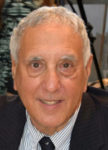
SAN DIEGO – Now that my wife and co-publisher Nancy and I have returned from our cruise, I’m pleased to say that San Diego Jewish World is resuming its daily publication. One is supposed to “get away from it all” on a vacation, but, given the fact that this online newspaper’s slogan is “There’s a Jewish story everywhere,” I couldn’t resist photographing evidence of Jewish influences wherever we set foot.
On a Holland America cruise that began in Fort Lauderdale, Florida, aboard MS Rotterdam, we had the occasion to not only celebrate Chanukah but also two Shabbats, which helped to form a vibrant and enjoyable shipboard Jewish community.
In the first photo below, Michael Rubenstein, an attorney from a suburb of Toronto, Canada, and Irvin Jacobs, a retired medical doctor from San Diego, joined in leading services on a Chanukah night that fell on Erev Shabbat. Jacobs writes a column on the weekly Torah portion for this publication. In the second photo, five women lit the candles on a subsequent Shabbat evening. They are, from left, Ivette Mezrahi of Mexico City; Shirley Confino-Rehder of Norfolk, Virginia; Debbie Choite of Vancouver, Canada; and Nancy Harrison and Jacqueline Jacobs, both of San Diego.
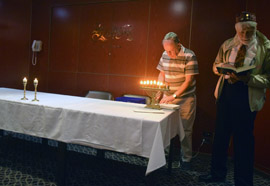
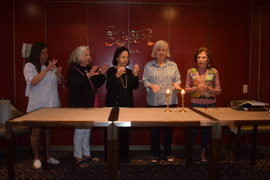
Curacao is the home of the longest standing synagogue still in use in the Western Hemisphere but, ironically, it was closed on Christmas Day, when our ship arrived on the Dutch Caribbean island. The photos below show the brightly colored exterior of the synagogue building as well as a Hebrew-language plaque offering welcome to all who enter. At the end of this photo essay is a reprint of a story that I wrote in 1990 about a visit to the synagogues in Curacao and in St. Thomas, Virgin Islands, which gives the flavor of what we would have seen on this most recent visit.
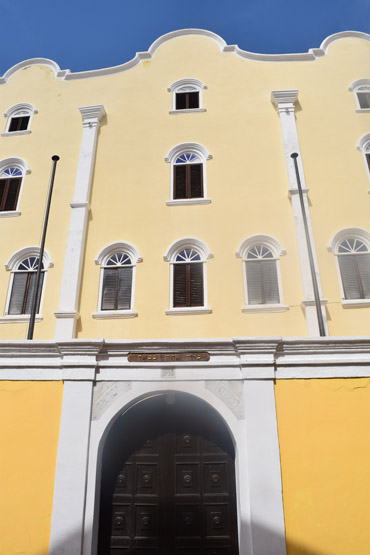
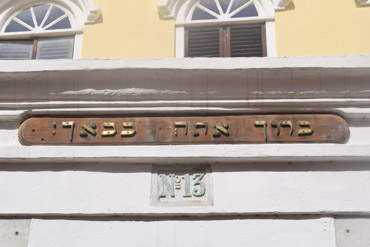
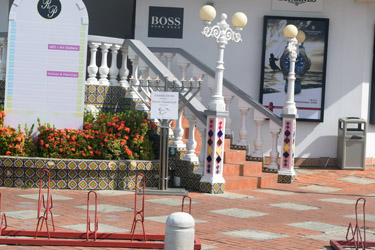
Next came Aruba where, I learned, the former prime minister, Mike Eman, follows the Jewish religion of his mother.
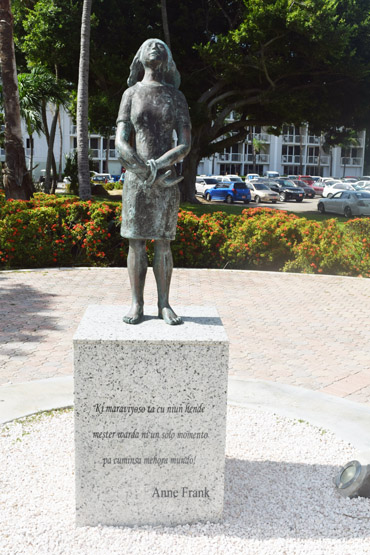
Chanukah menorahs were everywhere in evidence, including on the grounds of the Parliament building. On Aruba, there is an active Chabad house, which sends young yeshiva bokkers out in a car with a menorah strapped to its top and, on its sides, signs wishing everyone Happy Chanukah. Our Jewish guide, Marlon Pieters, pointed out that a more permanent indication of Aruba’s high esteem for the Jewish people is a statue of Anne Frank.
We went through the Panama Canal, but didn’t have the opportunity to disembark anywhere along its route, so I did not take any photos of obvious Jewish interest. However, in the past, I have written extensively of the Jewish connection to the Panama Canal. Here is a link to a story about its history that I wrote in 1999.
On the Pacific side of the canal, our first stop was in Costa Rica, where we fed white-faced capuchin monkeys that looked like they were wearing yarmulkes. From the window of our tour bus, we saw textiles for sale, including one designed that featured a hamsa.
Next was Nicaragua, where near the church of the town of Viejo, we noticed the Tienda Shalom (peace store), which according to its signage sold a great variety of articles. Pedaling nearby was a street vendor whose combination bicycle and pushcart was decorated with a Star of David.
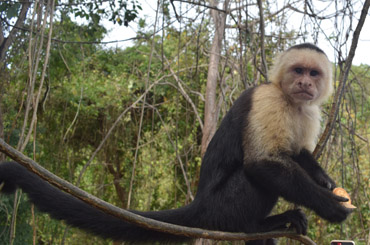
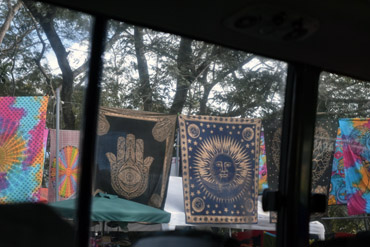
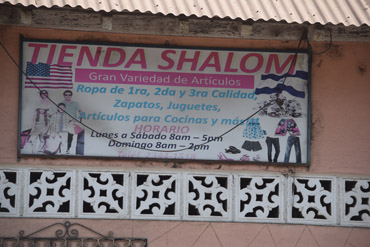
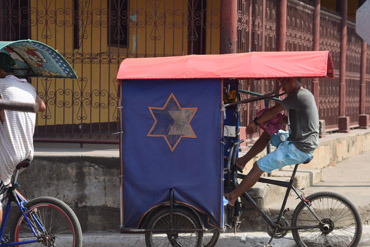
As we proceeded north toward San Diego, our next stop was in Guatemala where we rewarded in the major square of Antigua with a view of an ice cream cart that carried one of the Hebrew names of God: Shaddai. Nearby was another cart with the Hebrew name “Emanuel” which means “God is with us.”
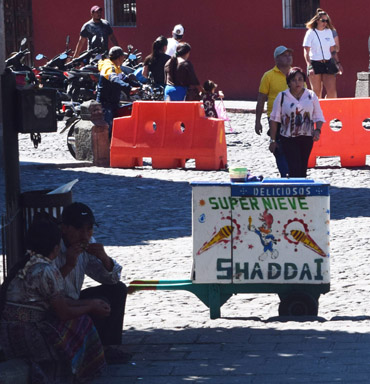
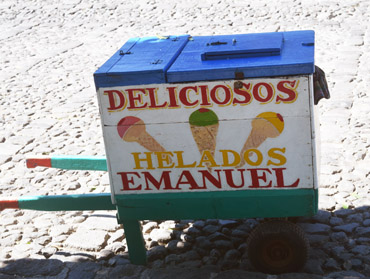
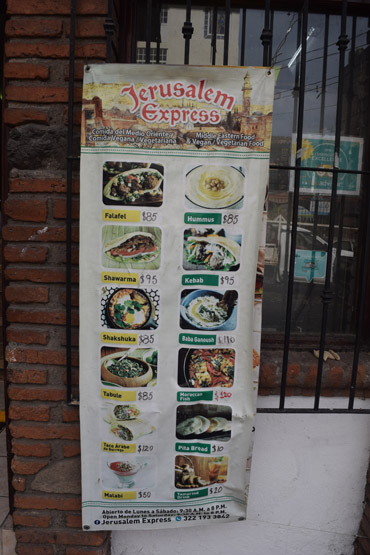
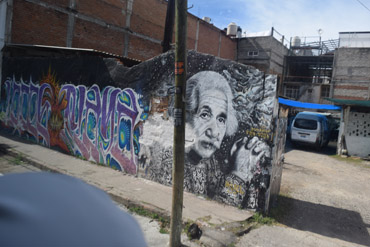
Our last cruise port before San Diego was Puerto Vallarta, Mexico. From our tour bus window, we spotted a mural of Albert Einstein. We also shopped on a street that boasted the Jerusalem Express, a Middle Eastern takeout restaurant offering such regional favorites as hummus, falafel, shwarma, and shakshuka.
All of which, to my mind, reiterated that the Jewish people and our religion are widely known and influential throughout the Caribbean and Central America, as well as the rest of the world.
*
Jews of Curacao and U.S. Virgin Islands
San Diego Jewish Press Heritage, October 12, 1990
In the old synagogues in Willemstad, Curacao, and in St. Thomas, Virgin Islands, one can predict the first question from visitors, whether they be Jew or Gentile:
“Why is the floor covered with sand?”
This one question prompts four different answers – three of them in the Dutch city of Willemstad, and yet another in the American territory of the Virgin Islands.
Rene Maduro, president of Curacao’s synagogue – the oldest synagogue in the Western Hemisphere – tells visitors that one reason for covering the floor with sand is “to remember the 40 years the Jews wandered in the desert in search for the Promised Land.”
For many years, in fact, local sands were augmented with small amounts of sand from the Holy Land to reinforce the symbolism.
Another reason, Maduro said, stems from the fact that the Jewish community was founded in 1651 by Sephardic Jews from Amsterdam, themselves the descendants of “secret Jews,” denounced as “Marranos” (pigs), who fled Spain and Portugal in search of religious freedom.
The sand, Maduro said, commemorates the fact that these secret Jews had to put sand on the floors of their attics to muffle the sounds of their services from the ears of anyone who might come into the main part of their homes below.
And the third reason?
In Genesis 22:17, God told Abraham that He will bestow His blessing upon him, and make his descendants as numerous as the sands of the seashore. The sand also symbolizes this.
Our guide in St. Thomas was Rebecca Colon, 15, a recent bat mitzvah, whose Puerto Rican father converted to his wife’s Judaism. The sand on the floor of her Reform shul, she said, is to remember that in Spain and Portugal the Jews had to pray “in unfinished basements.”
Both synagogues have benches arranged around a central prayer area, a Sephardic tradition helping to recall how prayer meetings would have been held in the desert.
Four interior pillars, each adorned with a name in Hebrew of matriarchs Sarah, Rebecca. Leah, and Rachel, symbolize in both synagogues that women uphold the Jewish faith, even as the columns support the ceiling. Rebecca Colon, wearing strands of jewelry with Jewish symbols, is very conscious of this as she proudly shows the St. Thomas synagogue to visitors.
See how dark parts of the walls are, she pointed out. One unique aspect of her shul is that it was not constructed from traditional cement, but instead from a mixture of sand and molasses. Must have been slow drying,.
Maduro and Colon are part of a tiny, historic Jewish community in the Caribbean – a community that has contributed a surprising number of famous people to history but which today is shrinking under the twin pressures of assimilation and attrition.
The Jewish populations of Willemstad and St. Thomas amount respectively to about 180 families in Curacao, and about 120 families in St. Thomas, according to Maduro and Colon. Alas, Maduro noted, “most of these families are into their 60s and 70s.”
Ironically, the cruise ship which brought us to Curacao and to St. Thomas, the Queen Elizabeth 2, arrived in the two ports on what for them were legal holidays: July 2, or “Flag Day” in Curacao, and July 3, or “Governor’s Day” in St. Thomas.
The fact that there were people on hand in the synagogues to greet visitors and to conduct tours bespoke their dedication. How many synagogues in mainland America would have kept people on the following day, July 4, “American Independence Day,” in order to be ready for visitors?
True, some of the visitors made welcome donations to the synagogues, helping the small Jewish communities in their never-ending battle to stay financially afloat, but, in candor, the contributions do not amount to very much. In an entire year, Maduro said the donations add up to between $2,000 and $3,000.
Typically, visitors give their tzedakah in coins rather than folding money. However, some take out overseas memberships at an annual rate of $300.
The synagogue pays its staff to open on holidays, not in the expectation of earning great revenues for the synagogue, but to fulfill its obligations to world Jewry, Maduro said. “People expect us to be open. They want to see the oldest synagogue.”
Officially called Mikve Israel-Emmanuel, the current structure housing Curacao’s synagogue was built in 1730, a date preceding by two years the birth of George Washington in Virginia, the U.S. educated Maduro likes to point out.
Mikve Israel originally followed traditional Orthodox forms. In 1864, there was a schism in the congregation leading to the establishment of Temple Emanuel, a Reform congregation. One hundred years later, to the year, the two congregations merged, forming Mikve Israel-Emmanuel. Together they declared their synagogue to be neither Orthodox nor Reform, but Reconstructionist.
Men and women sit together nowadays, whereas before women sat in the galleries. Only men serve on the board or are called to the Torah. Men are required to wear kippot. Prayers for the Royal Family of Holland are recited in front of the heychal when the Torahs re removed, but the prayers are in Portuguese.
During the service, the greatest honor is to be asked in Portuguese and Hebrew, “que abrira aos portas do heychal?” (Who will open the doors of the heychal?)
Members of the board sit ceremonially on the banca, a raised dais against the northern wall. Organ music had been a regular feature of both congregations’ services since the mid-1860s.
The synagogue, referred to simply as “our snoa” by members of the congregation, maintains a Jewish museum across a courtyard from the sanctuary. In this building, once was housed the mikvah. Here, one finds a display of various ritual objects, many of them taken out of their display case and brought into the synagogue on appropriate holidays. “This is a living museum,” Maduro explained.
As if a synagogue and museum were not enough for the small Jewish community of Curacao to maintain, the community also keeps up to cemeteries – one dating back to the first Jewish colonists of the mid-17th Century, the other more modern, having served both the traditional and Reform congregations from a time prior to their re-merger.
In the old cemetery of Bet Chayim Blehneim, the oldest inscription on record commemorates the tombstone of Jeudith Nunes de Fonseca, who died in 1668. More than 5,000 persons are buried six feet under the earth in Bet Chayim, their graves marked by huge slabs that because of their shape and size often are mistaken for above-ground stone coffins.
Many of these tombstones are covered with funereal art, depicting something about the manner of the deceased’s death, or perhaps recalling the Biblical figure after whom he or she was named.
People named Mordechai might be remembered with a sculpted depiction of the triumphal procession in which Mordechai of the Book of Esther participated, while those named Moses might be commemorated with a sculpture showing Moshe Rabenu hold the Ten Commandments.
As Maduro brushed pebbles and rocks left on the tombstones by well meaning but ill informed Ashkenazic Jews paying their respects –“This is not a Sephardic custom; it is an Ashkenazic custom,” Maduro explained – he grimaced at the coat of soot and grime that over the years has been obliterating the inscriptions on many of the graves.
Next door to the historic cemetery is an oil refinery, first operated by Royal Dutch Shell and today by a Venezuelan company. Even a plaque placed on a pillar to the lee of the smoke does not escape its effects. It can barely be read.
Impressions of some of the funereal sculptures were made several years ago for exhibition in the courtyard of the synagogue and museum, but many were long ago beyond saving. Five hundred people simply do not have the money to be able to afford reconstruction or restoration – even if it is the oldest Jewish cemetery in the Western hemisphere.
The people who lie in this cemetery witnessed so much history. One of the early governors of this colony was Peter Stuyvesant, who later would be transferred to Nieuw Amsterdam, where he would resist the first settlement of Jews in what would become the United States. His Dutch superiors, who numbered Jews on their board, overruled Stuyvesant’s anti-Semitic objections.
While governor of Curacao, Stuyvesant led a military expedition to the island of St. Maarten, which then was occupied by the Spaniards. His intent was to drive the Spaniards out and to claim the island for the Dutch. While subsequent skirmishes would accomplish that objective, Stuyvesant received for his troubles a cannon ball that took away one of his legs.
Among the earliest Jewish settlers in Curacao was a sister of the 17th Century philosopher Baruch Spinoza, who immigrated from Amsterdam. Also there was the Touro family, whose son, Judah, would help found the historic Synagogue in Newport, Rhode Island.
The Jews of Curacao welcomed the South American liberator, Simon Bolivar, during his six months of exile there. One member of the community who became Bolivar’s friend, adviser, and financial contributor was Dr. Mordechai Capriles. In Curacao, a famous painting depicts the two men standing at the seashore, looking in the direction of the Venezuelan coast, 30 miles away.
“We also helped financed the U.S. Revolution,” Maduro said. “In fact Admiral Rodney (of the British Navy) burned down St. Eustacius (another Dutch island in the Caribbean) in retribution for the help the American colonists received from the Jewish merchants there.
“We were the first country to recognize the U.S. flag,” Maduro said, recalling that when a ship flying the Stars and Stripes passed by St. Eustacius during the Revolutionary War, the city responded with a 13-gun salute.
The Jews of Curacao also helped augment the Jewish settlement of St. Thomas, which is believed to have begun the same time as the Danish West India Co. took possession of the island in 1672. Land records indicate a Jew named Jacob Elias owned a small plantation on St. Thomas in 1697.
In the 1730s, a Jew named Emmanuel Vass was appointed by the Danish government to assist in the negotiations with France for the purchase of the neighboring island of St. Croix.
In 1801, five years after Congregation B’racha v’Shalom was started, it counted nine Jewish families as members. With immigration from Curacao, St. Eustacius, England, and France, the number of families grew to 22 by 1803.
The next decade would see the birth of two Jews who would move to the United States, where they would attain prominence as Southern statesmen.
One was David Levi Yulee, who would become the first U.S. senator sent to Congress by the state of Florida in 1845, staying until he resigned in 1861 because of the outbreak of the Civil War.
The other was Judah O. Benjamin, who was born on neighboring St. Croix in 1811, and who would move to Louisiana, from where he too would be sent to Congress as a U.S. senator. Later he would serve in the Confederate cabinet of Jefferson Davis consecutively as attorney general, secretary of war, and secretary of state.
Twice while Yulee and Benjamin were growing to maturity, fires destroyed the synagogue of St. Thomas. But in 1833, the present structure was built and the congregation was given the hefty name of B’racha v’Shalom u’Gemilut Hasadim, which means “blessing and peace and loving deeds.”
Among the families living in St. Thomas at the time was that of controversial Abraham Pizara, the owner of a hardware store, whose marriage to the widow Rachel Mazzano Pomier Petit was refused recognition by Jewish authorities because Pizaro was the nephew of his wife’s dead husband.
The couple stayed together, nevertheless, having several children including a son born in 1830 named Jacob, who immediately displayed a flair for drawing and a disdain for his father’s world of business.
The father and the son argued over the boy’s chosen career, until the son went off with a Danish friend to Caracas, Venezuela, to pursue his art.
The son eventually returned to St. Thomas, where his father acceded to his wishes and agreed to help finance his art studies in Paris.
Jacob changed the spelling of his last name to Pissarro, and took the first name Camille. He would become known to the world as Camille Pissarro, “the father of French Impressionism.” He never returned to St. Thomas, but his works periodically are displayed proudly with those of other St. Thomians at Government House.
Today, the Pissarro home is used as a small office building set above a perfume shop on Main Street, which day in and day out is much crowded by visitors.
On the day we were in St. Thomas, four cruise ships were in port, Queen Elizabeth 2 of Cunard Line; Americanis of Chandris Cruises, Celebration of Carnival Cruises, and the Costa Riviera of Costa Cruises. Adding to the crowds were the men on liberty from the U.S. aircraft carrier Theodore Roosevelt of what seafarers merrily like to call the “gray line.”
In the old Pissarro house, Tom Johnston, president of the local board of realtors, told HERITAGE of his tentative plans to open an art gallery in rooms where the young Pissarro once might have painted. Already, said Johnston, he has been able to obtain some works from a great-granddaughter of Pissarro who lives in London and operates galleries in London and Tel Aviv.
While not Jewish, Johnston and his wife Barbara were familiar with the Jewish community in St. Thomas, recalling that the novelist Herman Wouk, perhaps best known for The Caine Mutiny, once lived there.
A prominent member of the Virgin Islands legislature, he said, is Alan Paul Shatkin, a Jew whose Black wife recently was named “Mrs. Virgin Islands.” The couple has a child named Micah.
Nautical types often have compared the layout of the Charlotte Amalie section of St. Thomas to a three-masted ship, with prominent hills named by sailors as Foretop Hill, Maintop Hill, and Mizzenmast Hill. Locals know them respectively as Government Hill, where the governor lives; Synagogue Hill, and Denmark Hill.
The street up to the synagogue is steep and narrow, and this fact is commemorated by a whimsical T-shirt on sale in the shul’s gift shop. “I climbed Synagogue Hill,” it proclaims. After purchasing one, I wore it on my ship and fond my fellow Jewish passengers wanted to photograph the shirt – not me, the shirt!
In 1917, the Virgin Islands were purchased by the United States from Denmark, bringing to the synagogue a new status. Whereas it is the second oldest synagogue in the Western Hemisphere, it is the oldest synagogue to be in continuous use in a land flying the American flag.
In 1950, a Jew was selected by President Harry Truman’s administration to serve as the American governor of the Virgin Islands. He was Morris Fidanque de Castro, who also served two terms as president of the Hebrew congregation of St. Thomas.
Again in 1961, a Jew was named to the governorship. President John F. Kennedy appointed Ralph M. Paiewonsky, who served until 1969. One of Paiewonsky’s commissioners was Henry Kimelman who later would be appointed by President Jimmy Carter as U.S. ambassador to Haiti.
While Maduro lives in Curacao, he keeps himself informed about the affairs of Central America and the rest of the Caribbean as part of his responsibilities as the new president for B’nai B’rith District 23.
In his territory are Mexico, Guatemala, Honduras, Costa Rica, Nicaragua, Panama, Colombia, Venezuela, Curacao, the Virgin Islands, Jamaica, Cuba, Surinam, and El Salvador.
One of Maduro’s hopes is that the Jewish communities in these various countries will help rally their governments behind an effort being contemplated in the United Nations to rescind the infamous resolution adopted in 1975 equating Zionism with racism.
(Coincidentally, the distinguished lecturer on our ship was John Scali ABC newsman and former U.S. ambassador to the U.N., who served in the world body at the time of that resolution. Scali, however, declined to be interviewed by HERITAGE on the subject, saying he had suffered from many attacks during the period and didn’t want to relive it. He was not willing to elaborate.)
As district B’nai B’rith president, Maduro is concerned about the effect of current affairs on the Jewish populations throughout the region. For example, he said, in Panama, the Jewish community suffered terrible losses in the destruction that accompanied the U.S. invasion last year that ousted Gen. Manuel Noriega from power.
The fires that gutted their stores and the subsequent looting of their stores have been declared by the insurance companies as “acts of war,” meaning none of the losses were covered by insurance.
On the brighter side, the Panama community is pulling together, sending its children to a new Jewish school named for Albert Einstein, Maduro said. In the Noriega days, he said, many Jewish families were afraid to send their children openly to Jewish schools.
In Colombia, where drug wars and terrorism dominate government affairs, Jewish merchants live in fear of kidnaping, Maduro said. In Mexico, he reported, the Jewish community recently was successful in finding a way to legally discourage publication of various anti-Semitic works, including Hitler’s Mein Kampf.
The community leader just recently began his two-year term as B’nai B’rith district president and expects to visit each of the countries under his jurisdiction at lest once a year.
Given the high level of integration and acceptance that Jews have attained in their more than 300 years of history in the Caribbean, Maduro said he hopes he can dedicate his district presidency to spreading the ideals of B’nai B’rith: the promotion of benevolence, love, and harmony.
“I’d like to see us caring for people, visiting the sick, and going back to the values we have historically held dear as Jews,” Maduro said. “Too many of us become involved only with the modern world of Betamaxes.”
*
Donald H. Harrison is editor of San Diego Jewish World. He may be contacted via donald.harrison@sdjewishworld.com
Great Post. Thanks for sharing.